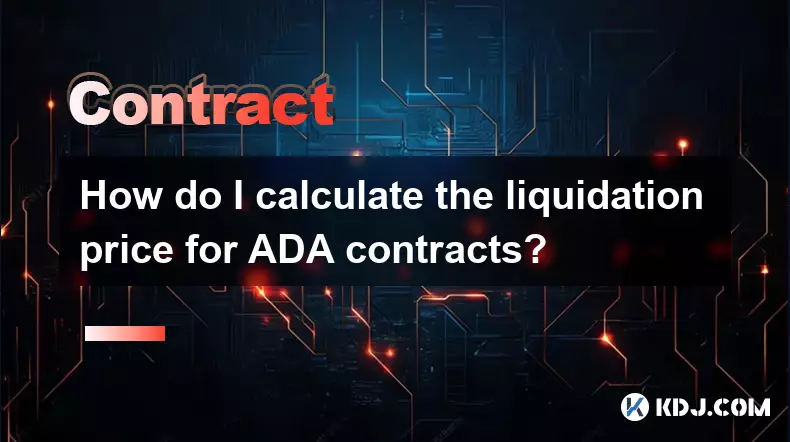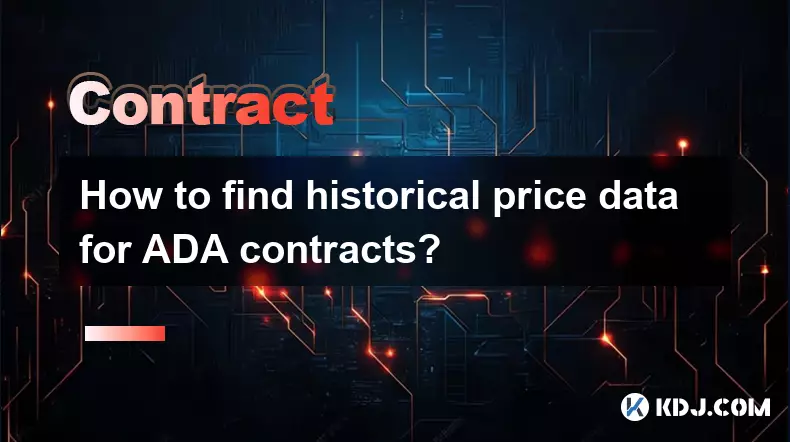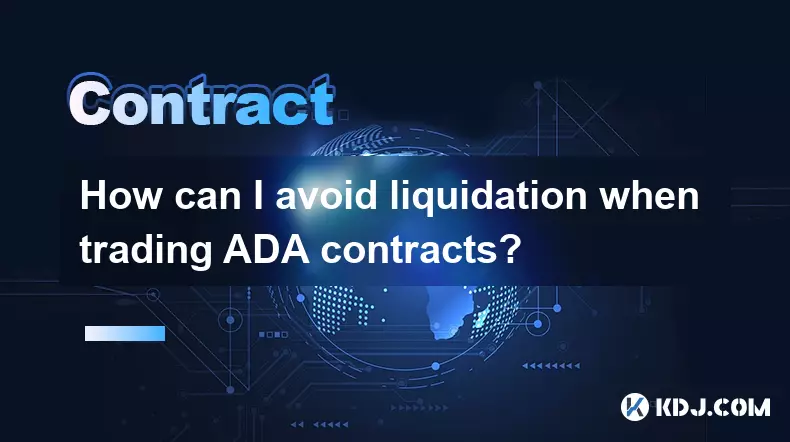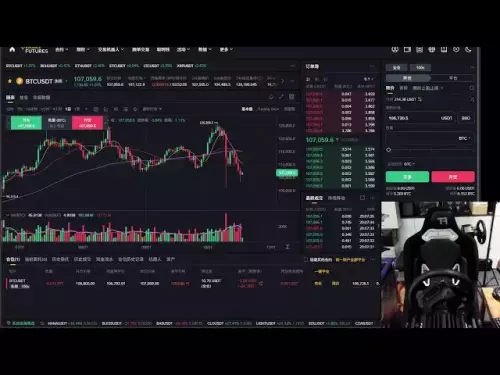-
 bitcoin
bitcoin $106975.071866 USD
-0.29% -
 ethereum
ethereum $3871.670850 USD
-0.07% -
 tether
tether $1.000261 USD
-0.01% -
 bnb
bnb $1084.417621 USD
-0.50% -
 xrp
xrp $2.348167 USD
0.82% -
 solana
solana $185.621736 USD
0.45% -
 usd-coin
usd-coin $0.999833 USD
-0.04% -
 tron
tron $0.313423 USD
0.81% -
 dogecoin
dogecoin $0.188856 USD
0.54% -
 cardano
cardano $0.630416 USD
-0.49% -
 hyperliquid
hyperliquid $36.506353 USD
2.24% -
 ethena-usde
ethena-usde $0.999584 USD
-0.01% -
 chainlink
chainlink $16.750026 USD
-0.77% -
 stellar
stellar $0.313373 USD
0.37% -
 bitcoin-cash
bitcoin-cash $465.978560 USD
-1.57%
How do I calculate the liquidation price for ADA contracts?
The liquidation price in ADA futures is the level at which a leveraged position is automatically closed to prevent further losses, influenced by margin, leverage, and market volatility.
Oct 18, 2025 at 01:18 am

Understanding Liquidation Price in ADA Futures Contracts
1. The liquidation price in ADA futures trading refers to the market price at which a leveraged position is automatically closed by the exchange due to insufficient margin. This mechanism protects traders and the platform from further losses when the market moves against an open position. Each contract has its own parameters, including leverage, entry price, and maintenance margin requirements, all of which directly influence the liquidation threshold.
2. Exchanges use different methods to calculate liquidation prices depending on their risk models. For inverse contracts, the formula may differ from linear ones. In the case of ADA, which is typically traded as a linear perpetual contract, the calculation focuses on the notional value of the position relative to the available margin and fees. A drop in account equity below the maintenance margin triggers the liquidation engine.
3. Traders must monitor their positions closely, especially during high volatility. Sudden price swings in ADA can rapidly approach liquidation levels, particularly with higher leverage. Most platforms provide real-time indicators showing how close a position is to being liquidated, often displayed as a percentage or distance from the current market price.
Key Variables in Liquidation Calculations
1. Entry price is the average price at which the position was opened. It serves as the baseline for calculating unrealized profit or loss. The farther the market moves from this point, the greater the impact on margin balance.
2. Leverage level determines how much exposure a trader gains relative to their margin. A 10x leverage means that a 10% adverse move could lead to full liquidation if no additional margin is added. Higher leverage reduces the buffer against price fluctuations.
3. Maintenance margin is the minimum amount of equity required to keep a position open. It is usually a small percentage of the position size, ranging from 0.5% to 1% on major exchanges. This value is critical in determining how much price movement the position can withstand.
4. Position size, measured in ADA coins or USD value, affects the sensitivity of the liquidation price. Larger positions require more margin and are more vulnerable to sudden shifts unless adequately collateralized.
Step-by-Step Calculation Method
1. Identify the position type: long or short. For a long position, the liquidation price is below the entry price; for a short, it’s above. The direction determines whether falling or rising prices pose the threat.
2. Use the formula: Liquidation Price = Entry Price × (1 − Initial Margin Rate + Maintenance Margin Rate) for longs, adjusting signs accordingly for shorts. Initial margin rate depends on leverage—for example, 10x leverage implies a 10% initial margin.
3. Account for funding payments if applicable. While funding doesn’t directly alter the liquidation price, negative funding rates over time erode available margin, effectively bringing the position closer to liquidation.
4. Adjust for fee deductions. Some platforms include taker fees in their liquidation models, meaning transaction costs during forced closures are factored into the required margin buffer.
Risk Management Strategies Around Liquidation
1. Set stop-loss orders slightly above the estimated liquidation price to retain control over exit timing. This avoids relying solely on the exchange’s automated system, which might execute at less favorable rates during slippage.
2. Maintain excess margin beyond the minimum requirement. Keeping a healthy equity-to-margin ratio reduces the likelihood of unexpected liquidations during flash crashes or pump-and-dump scenarios common in altcoin markets like ADA.
3. Monitor exchange-specific liquidation engines. Some platforms use partial liquidation models, closing portions of a position instead of the entire amount. Understanding these mechanics helps anticipate behavior under stress conditions.
4. Avoid maximum leverage on volatile assets. Cardano’s price can experience sharp movements based on protocol upgrades or macroeconomic factors. Using moderate leverage provides breathing room even when predictions go awry.
Frequently Asked Questions
What happens when an ADA contract gets liquidated?The exchange closes the position using a liquidation engine, often through a decentralized insurance fund or auto-deleveraging system. The trader loses the initial margin allocated to that trade.
Can I recover funds after a liquidation?No direct recovery is possible once liquidation occurs. However, some platforms offer partial refunds via insurance funds if the closure results in positive realization, though this is rare in deeply underwater positions.
Do all exchanges calculate ADA liquidation prices the same way?No. Different platforms apply varying formulas, especially regarding fee structures and margin tiers. Always consult the specific exchange’s documentation for precise methodology.
Is the liquidation price fixed after opening a position?It remains relatively stable unless additional margin is added or the position is adjusted. Changes in funding rates or maintenance margin policies by the exchange can also shift the effective liquidation level.
Disclaimer:info@kdj.com
The information provided is not trading advice. kdj.com does not assume any responsibility for any investments made based on the information provided in this article. Cryptocurrencies are highly volatile and it is highly recommended that you invest with caution after thorough research!
If you believe that the content used on this website infringes your copyright, please contact us immediately (info@kdj.com) and we will delete it promptly.
- Dota 2 YouTube Hack: Solana Scam Exposes Esports Security Flaws
- 2025-10-19 18:25:13
- Pumpfun's PUMP Price: Comeback Reasons and What's Next!
- 2025-10-19 18:25:13
- DYDX Hits Annual Lows: Analyst Call Fails to Ignite Rally
- 2025-10-19 18:30:13
- Internet Computer's Bearish Plunge: Is a 52-Week Low the End?
- 2025-10-19 18:30:13
- ENS on the Edge: Bollinger Bands and Bearish Momentum
- 2025-10-19 18:35:12
- ONDO's Wild Ride: Bollinger Bands and Oversold Territory – What's Next?
- 2025-10-19 18:35:12
Related knowledge

What are quarterly vs. perpetual ADA contracts?
Oct 19,2025 at 08:55am
Understanding Quarterly and Perpetual ADA ContractsDerivatives trading in the cryptocurrency space has expanded rapidly, offering traders various inst...

How to find historical price data for ADA contracts?
Oct 18,2025 at 10:18pm
Understanding ADA and Its Market Data Availability1. Cardano’s native cryptocurrency, ADA, operates on a decentralized blockchain that supports smart ...

How to hedge my spot Cardano portfolio with ADA contracts?
Oct 18,2025 at 05:36am
Hedging Your ADA Spot Holdings Using Derivatives1. Identify a reliable exchange that offers ADA futures or perpetual contracts. Exchanges like Binance...

How are the trading fees for ADA contracts calculated on Binance?
Oct 19,2025 at 03:18pm
Understanding ADA Futures Fee Structure on Binance1. Trading fees for ADA perpetual contracts on Binance are determined using a tiered system based on...

How can I avoid liquidation when trading ADA contracts?
Oct 18,2025 at 01:37am
Understanding Liquidation in ADA Futures Trading1. Liquidation occurs when a trader’s margin balance falls below the maintenance threshold required to...

How do you calculate profit and loss (PnL) for ADA contracts?
Oct 19,2025 at 12:18pm
Understanding ADA Contract Mechanics1. ADA contracts operate within the Cardano blockchain ecosystem, where smart contracts govern transaction logic a...

What are quarterly vs. perpetual ADA contracts?
Oct 19,2025 at 08:55am
Understanding Quarterly and Perpetual ADA ContractsDerivatives trading in the cryptocurrency space has expanded rapidly, offering traders various inst...

How to find historical price data for ADA contracts?
Oct 18,2025 at 10:18pm
Understanding ADA and Its Market Data Availability1. Cardano’s native cryptocurrency, ADA, operates on a decentralized blockchain that supports smart ...

How to hedge my spot Cardano portfolio with ADA contracts?
Oct 18,2025 at 05:36am
Hedging Your ADA Spot Holdings Using Derivatives1. Identify a reliable exchange that offers ADA futures or perpetual contracts. Exchanges like Binance...

How are the trading fees for ADA contracts calculated on Binance?
Oct 19,2025 at 03:18pm
Understanding ADA Futures Fee Structure on Binance1. Trading fees for ADA perpetual contracts on Binance are determined using a tiered system based on...

How can I avoid liquidation when trading ADA contracts?
Oct 18,2025 at 01:37am
Understanding Liquidation in ADA Futures Trading1. Liquidation occurs when a trader’s margin balance falls below the maintenance threshold required to...

How do you calculate profit and loss (PnL) for ADA contracts?
Oct 19,2025 at 12:18pm
Understanding ADA Contract Mechanics1. ADA contracts operate within the Cardano blockchain ecosystem, where smart contracts govern transaction logic a...
See all articles





















![[4K 60fps] Astral by oc3andark (1 Coin) [4K 60fps] Astral by oc3andark (1 Coin)](/uploads/2025/10/19/cryptocurrencies-news/videos/k-fps-astral-ocandark-coin/68f438453fa33_image_500_375.webp)




















































